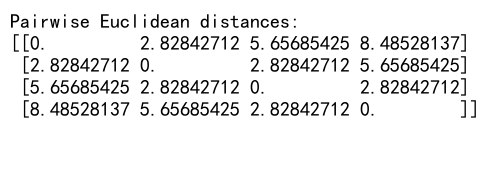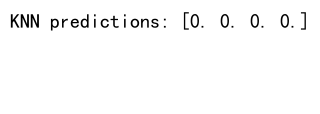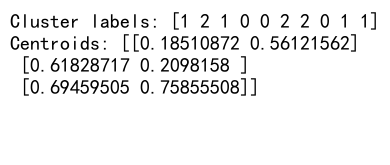How to Calculate the Euclidean Distance Using NumPy
Calculate the Euclidean distance using NumPy is a fundamental operation in many scientific and data analysis applications. NumPy, a powerful library for numerical computing in Python, provides efficient tools to perform this calculation. In this article, we’ll explore various methods to calculate the Euclidean distance using NumPy, along with practical examples and explanations.
Understanding Euclidean Distance
Before we dive into calculating the Euclidean distance using NumPy, let’s briefly review what Euclidean distance is. The Euclidean distance is the straight-line distance between two points in Euclidean space. It’s named after the ancient Greek mathematician Euclid and is widely used in mathematics, physics, and computer science.
For two points in n-dimensional space, the Euclidean distance is calculated as the square root of the sum of the squared differences between the corresponding coordinates. Mathematically, for points p and q in n-dimensional space, the Euclidean distance is:
distance = sqrt((p1 - q1)^2 + (p2 - q2)^2 + ... + (pn - qn)^2)
Now, let’s explore how to calculate the Euclidean distance using NumPy.
Basic Euclidean Distance Calculation Using NumPy
To calculate the Euclidean distance using NumPy, we’ll start with a simple example of calculating the distance between two points in 2D space.
import numpy as np
# Define two points
point1 = np.array([1, 2])
point2 = np.array([4, 6])
# Calculate the Euclidean distance
distance = np.sqrt(np.sum((point1 - point2)**2))
print("Euclidean distance between points:", distance)
Output:

In this example, we define two points as NumPy arrays and use the formula for Euclidean distance. The np.sqrt() function calculates the square root, while np.sum() adds up the squared differences.
Calculating Euclidean Distance for Multiple Points
Often, we need to calculate the Euclidean distance using NumPy for multiple points simultaneously. NumPy’s broadcasting capabilities make this task efficient.
import numpy as np
# Define multiple points
points = np.array([[1, 2], [3, 4], [5, 6]])
reference_point = np.array([0, 0])
# Calculate Euclidean distances
distances = np.sqrt(np.sum((points - reference_point)**2, axis=1))
print("Euclidean distances from reference point:", distances)
Output:

This example calculates the Euclidean distance using NumPy between multiple points and a reference point. The axis=1 parameter in np.sum() ensures we sum along the rows.
Using NumPy’s linalg.norm for Euclidean Distance
NumPy provides a more concise way to calculate the Euclidean distance using the linalg.norm function.
import numpy as np
# Define two points
point1 = np.array([1, 2, 3])
point2 = np.array([4, 5, 6])
# Calculate the Euclidean distance
distance = np.linalg.norm(point1 - point2)
print("Euclidean distance using linalg.norm:", distance)
Output:

This method is more efficient and readable, especially for higher-dimensional points.
Calculating Pairwise Euclidean Distances
In many applications, we need to calculate the Euclidean distance using NumPy between all pairs of points in a dataset. NumPy provides efficient ways to do this.
import numpy as np
# Define a set of points
points = np.array([[1, 2], [3, 4], [5, 6], [7, 8]])
# Calculate pairwise Euclidean distances
pairwise_distances = np.sqrt(np.sum((points[:, np.newaxis, :] - points[np.newaxis, :, :])**2, axis=-1))
print("Pairwise Euclidean distances:")
print(pairwise_distances)
Output:

This example uses broadcasting to calculate the Euclidean distance using NumPy between all pairs of points efficiently.
Euclidean Distance in Machine Learning
Calculating the Euclidean distance using NumPy is crucial in many machine learning algorithms, such as k-Nearest Neighbors (k-NN). Let’s see an example of how to use Euclidean distance in a simple k-NN implementation.
import numpy as np
def knn_predict(X_train, y_train, X_test, k=3):
distances = np.sqrt(np.sum((X_train[:, np.newaxis] - X_test)**2, axis=2))
nearest_neighbor_ids = distances.argsort()[:, :k]
nearest_neighbor_labels = y_train[nearest_neighbor_ids]
return np.mean(nearest_neighbor_labels, axis=1)
# Example usage
X_train = np.array([[1, 2], [3, 4], [5, 6], [7, 8]])
y_train = np.array([0, 0, 1, 1])
X_test = np.array([[2, 3], [6, 7]])
predictions = knn_predict(X_train, y_train, X_test)
print("KNN predictions:", predictions)
Output:

This example demonstrates how to use Euclidean distance in a k-NN algorithm to make predictions based on the nearest neighbors.
Optimizing Euclidean Distance Calculations
When dealing with large datasets, optimizing Euclidean distance calculations becomes crucial. Let’s explore some techniques to improve performance.
Using np.einsum for Efficient Computation
The np.einsum function can be used to calculate the Euclidean distance using NumPy more efficiently, especially for large arrays.
import numpy as np
def efficient_euclidean_distance(A, B):
return np.sqrt(np.einsum('ij,ij->i', A-B, A-B))
# Example usage
A = np.random.rand(1000, 3)
B = np.random.rand(1000, 3)
distances = efficient_euclidean_distance(A, B)
print("Efficient Euclidean distances:", distances[:5]) # Print first 5 distances
Output:

This method is particularly useful when calculating distances between corresponding points in two large arrays.
Squared Euclidean Distance
In some applications, using the squared Euclidean distance can be more efficient, as it avoids the computationally expensive square root operation.
import numpy as np
def squared_euclidean_distance(A, B):
return np.sum((A - B)**2, axis=1)
# Example usage
A = np.array([[1, 2, 3], [4, 5, 6]])
B = np.array([[7, 8, 9], [10, 11, 12]])
squared_distances = squared_euclidean_distance(A, B)
print("Squared Euclidean distances:", squared_distances)
Output:

This can be particularly useful in algorithms where the relative distances are more important than the absolute distances.
Euclidean Distance in Higher Dimensions
Calculating the Euclidean distance using NumPy in higher-dimensional spaces is straightforward with NumPy’s capabilities.
import numpy as np
# Define points in 5D space
point1 = np.array([1, 2, 3, 4, 5])
point2 = np.array([6, 7, 8, 9, 10])
# Calculate Euclidean distance
distance = np.linalg.norm(point1 - point2)
print("Euclidean distance in 5D space:", distance)
Output:

This example demonstrates how easy it is to calculate the Euclidean distance using NumPy in higher-dimensional spaces.
Weighted Euclidean Distance
In some applications, we might want to give different weights to different dimensions when calculating the Euclidean distance using NumPy.
import numpy as np
def weighted_euclidean_distance(A, B, weights):
return np.sqrt(np.sum(weights * (A - B)**2, axis=1))
# Example usage
A = np.array([[1, 2, 3], [4, 5, 6]])
B = np.array([[7, 8, 9], [10, 11, 12]])
weights = np.array([0.5, 1, 2])
weighted_distances = weighted_euclidean_distance(A, B, weights)
print("Weighted Euclidean distances:", weighted_distances)
Output:

This example shows how to incorporate weights into the Euclidean distance calculation, which can be useful in feature-weighted algorithms.
Euclidean Distance in Image Processing
Calculating the Euclidean distance using NumPy is often used in image processing tasks. Let’s see an example of calculating the distance between pixel values.
import numpy as np
def pixel_distance(image1, image2):
return np.sqrt(np.sum((image1 - image2)**2, axis=2))
# Example usage with simulated images
image1 = np.random.randint(0, 256, (100, 100, 3))
image2 = np.random.randint(0, 256, (100, 100, 3))
distances = pixel_distance(image1, image2)
print("Pixel distances shape:", distances.shape)
print("Sample pixel distances:", distances[0, 0:5])
Output:

This example demonstrates how to calculate the Euclidean distance between corresponding pixels in two images.
Euclidean Distance in Clustering Algorithms
Clustering algorithms often rely on Euclidean distance calculations. Let’s implement a simple k-means clustering algorithm using Euclidean distance.
import numpy as np
def kmeans(X, k, max_iters=100):
centroids = X[np.random.choice(X.shape[0], k, replace=False)]
for _ in range(max_iters):
distances = np.sqrt(((X - centroids[:, np.newaxis])**2).sum(axis=2))
labels = np.argmin(distances, axis=0)
new_centroids = np.array([X[labels == i].mean(axis=0) for i in range(k)])
if np.all(centroids == new_centroids):
break
centroids = new_centroids
return labels, centroids
# Example usage
X = np.random.rand(1000, 2) # 1000 points in 2D
labels, centroids = kmeans(X, k=3)
print("Cluster labels:", labels[:10]) # Print first 10 labels
print("Centroids:", centroids)
Output:

This example shows how Euclidean distance is used in the k-means clustering algorithm to assign points to clusters and update centroids.
Euclidean Distance in Anomaly Detection
Euclidean distance can be used in anomaly detection algorithms. Here’s a simple example using the Mahalanobis distance, which is a generalization of Euclidean distance.
import numpy as np
def mahalanobis_distance(x, data):
mean = np.mean(data, axis=0)
cov = np.cov(data.T)
inv_cov = np.linalg.inv(cov)
diff = x - mean
return np.sqrt(diff.dot(inv_cov).dot(diff.T))
# Example usage
data = np.random.multivariate_normal([0, 0], [[1, 0.5], [0.5, 1]], size=1000)
point = np.array([3, 3])
distance = mahalanobis_distance(point, data)
print("Mahalanobis distance:", distance)
Output:

This example demonstrates how to use a distance metric based on Euclidean distance for anomaly detection.
Euclidean Distance in Recommendation Systems
Recommendation systems often use Euclidean distance to find similar items or users. Here’s a simple example of finding similar users based on their ratings.
import numpy as np
def find_similar_users(user_ratings, target_user, k=3):
distances = np.sqrt(np.sum((user_ratings - target_user)**2, axis=1))
similar_user_indices = np.argsort(distances)[1:k+1] # Exclude the user itself
return similar_user_indices
# Example usage
user_ratings = np.array([
[5, 4, 0, 2, 1],
[3, 2, 4, 4, 5],
[1, 2, 3, 5, 4],
[0, 3, 5, 1, 2],
[4, 3, 2, 1, 0]
])
target_user = user_ratings[0]
similar_users = find_similar_users(user_ratings, target_user)
print("Similar users:", similar_users)
Output:

This example shows how Euclidean distance can be used to find similar users in a recommendation system based on their ratings.
Conclusion
Calculating the Euclidean distance using NumPy is a versatile and powerful technique with applications across various fields of data science and machine learning. From basic distance calculations to complex algorithms like clustering and anomaly detection, NumPy provides efficient tools to perform these operations.
In this article, we’ve explored various methods to calculate the Euclidean distance using NumPy, including basic calculations, optimized methods, and applications in different domains. We’ve seen how NumPy’s array operations and broadcasting capabilities make it easy to perform these calculations efficiently, even on large datasets.